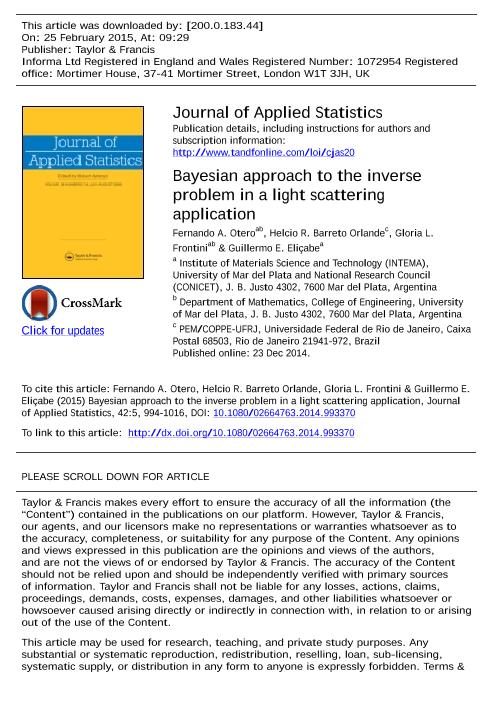Mostrar el registro sencillo del ítem
dc.contributor.author
Otero, Fernando Agustín

dc.contributor.author
Barreto Orlande, Helcio R.
dc.contributor.author
Frontini, Gloria Lia

dc.contributor.author
Elicabe, Guillermo Enrique

dc.date.available
2016-04-07T15:33:50Z
dc.date.issued
2014-11-25
dc.identifier.citation
Otero, Fernando Agustín; Barreto Orlande, Helcio R.; Frontini, Gloria Lia; Elicabe, Guillermo Enrique; Bayesian approach to the inverse problem in a light scattering application; Routledge Journals, Taylor & Francis Ltd; Journal of Applied Statistics; 42; 5; 25-11-2014; 994-1016
dc.identifier.issn
0266-4763
dc.identifier.uri
http://hdl.handle.net/11336/5055
dc.description.abstract
In this article, static light scattering (SLS) measurements are processed to estimate the particle size distribution of particle systems incorporating prior information obtained from an alternative experimental technique: scanning electron microscopy (SEM). For this purpose we propose two Bayesian schemes (one parametric and another non-parametric) to solve the stated light scattering problem and take advantage of the obtained results to summarize some features of the Bayesian approach within the context of inverse problems. The features presented in this article include the improvement of the results when some useful prior information from an alternative experiment is considered instead of a non-informative prior as it occurs in a deterministic maximum likelihood estimation. This improvement will be shown in terms of accuracy and precision in the corresponding results and also in terms of minimizing the effect of multiple minima by including significant information in the optimization. Both Bayesian schemes are implemented using Markov Chain Monte Carlo methods. They have been developed on the basis of the Metropolis–Hastings (MH) algorithm using Matlab® and are tested with the analysis of simulated and experimental examples of concentrated and semi-concentrated particles. In the simulated examples, SLS measurements were generated using a rigorous model, while the inversion stage was solved using an approximate model in both schemes and also using the rigorous model in the parametric scheme. Priors from SEM micrographs were also simulated and experimented, where the simulated ones were obtained using a Monte Carlo routine. In addition to the presentation of these features of the Bayesian approach, some other topics will be discussed, such as regularization and some implementation issues of the proposed schemes, among which we remark the selection of the parameters used in the MH algorithm.
dc.format
application/pdf
dc.language.iso
eng
dc.publisher
Routledge Journals, Taylor & Francis Ltd

dc.rights
info:eu-repo/semantics/openAccess
dc.rights.uri
https://creativecommons.org/licenses/by-nc-sa/2.5/ar/
dc.subject
Bayesian Estimation
dc.subject
Particle Size Distribution
dc.subject
Inverse Problem
dc.subject
Metropolis-Hastings
dc.subject
Static Light Scattering
dc.subject.classification
Estadística y Probabilidad

dc.subject.classification
Matemáticas

dc.subject.classification
CIENCIAS NATURALES Y EXACTAS

dc.title
Bayesian approach to the inverse problem in a light scattering application
dc.type
info:eu-repo/semantics/article
dc.type
info:ar-repo/semantics/artículo
dc.type
info:eu-repo/semantics/publishedVersion
dc.date.updated
2016-05-06 15:52:43.262787-03
dc.journal.volume
42
dc.journal.number
5
dc.journal.pagination
994-1016
dc.journal.pais
Reino Unido

dc.journal.ciudad
Londres
dc.description.fil
Fil: Otero, Fernando Agustín. Consejo Nacional de Investigaciones Científicas y Técnicas. Centro Científico Tecnológico Mar del Plata. Instituto de Investigación En Ciencia y Tecnología de Materiales (i); Argentina. Universidad Nacional de Mar del Plata. Facultad de Ingeniería; Argentina
dc.description.fil
Fil: Barreto Orlande, Helcio R.. Universidade Federal Do Rio de Janeiro. Inst A.luiz Coimbra de Pos-graduacao E Pesquisa de Engenharia; Brasil
dc.description.fil
Fil: Frontini, Gloria Lia. Consejo Nacional de Investigaciones Científicas y Técnicas. Centro Científico Tecnológico Mar del Plata. Instituto de Investigación En Ciencia y Tecnología de Materiales (i); Argentina. Universidad Nacional de Mar del Plata. Facultad de Ingeniería; Argentina
dc.description.fil
Fil: Elicabe, Guillermo Enrique. Consejo Nacional de Investigaciones Científicas y Técnicas. Centro Científico Tecnológico Mar del Plata. Instituto de Investigación En Ciencia y Tecnología de Materiales (i); Argentina. Universidad Nacional de Mar del Plata. Facultad de Ingeniería; Argentina
dc.journal.title
Journal of Applied Statistics

dc.relation.alternativeid
info:eu-repo/semantics/altIdentifier/doi/10.1080/02664763.2014.993370
dc.relation.alternativeid
info:eu-repo/semantics/altIdentifier/url/http://www.tandfonline.com/doi/abs/10.1080/02664763.2014.993370http://www.tandfonline.com/doi/abs/10.1080/02664763.2014.993370
dc.relation.alternativeid
info:eu-repo/semantics/altIdentifier/issn/0266-4763
dc.relation.alternativeid
info:eu-repo/semantics/altIdentifier/doi/http://dx.doi.org/10.1080/02664763.2014.993370
dc.relation.alternativeid
info:eu-repo/semantics/altIdentifier/doi/http://www.tandfonline.com/doi/abs/10.1080/02664763.2014.993370
Archivos asociados
